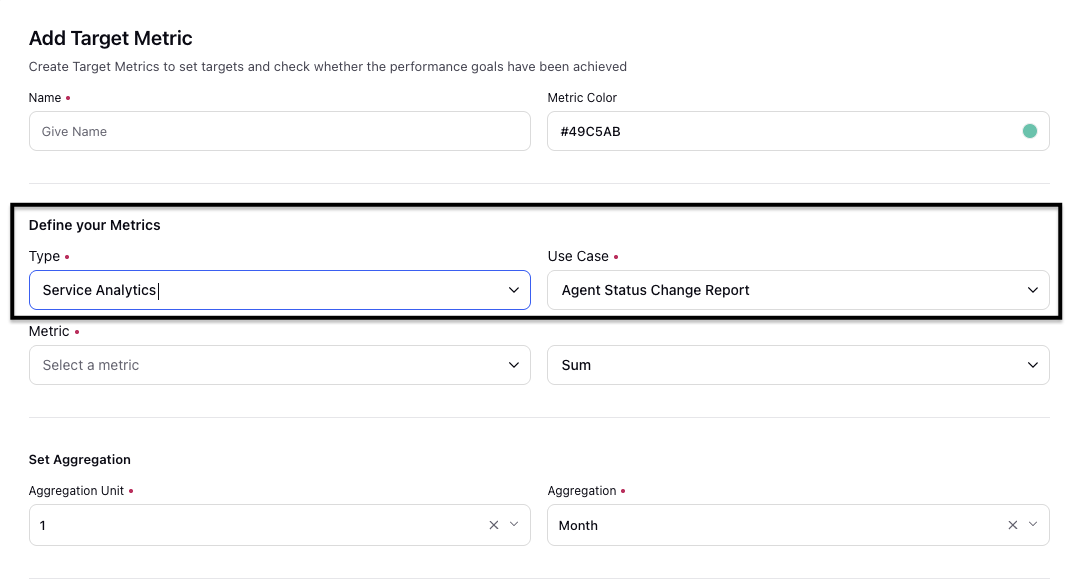Target metrics
Updated
Within Reporting, you can designate Target Metrics which will be displayed on a widget graph alongside the actual metrics. Target Metrics allow you to compare the actual performance of a metric against a pre-set goal. It also helps you set targets and performs reporting to check whether the performance goals have been achieved or not. Target Metrics are also used to define quantitative measurements for the quality of your posts and campaigns..
The visualization of setting target metrics in the Reporting Dashboard helps you make an informed change in the budget allocation of a campaign to achieve its objectives.
As always, care must be taken while defining the target metrics.
Limit the metrics to a set that can be realistically monitored.
If set too high, they may be completely unattainable.
Ensure that they can be repeatedly and consistently measured.
Provide balance across the different factors being measured.
Prioritize the metrics according to their significance to the posts and campaigns.
Note If you select the Workspace name, Target Metrics will be visible to all users who are either Global admin or Global User. For users who are either Workspace Admin or Workspace User, you need to select both Workspace Name and User/User Groups. |
To Add Target Metrics
Click the New Tab icon. Under the Sprinklr Social tab, click Reporting within Analyze.
On the Reporting Home, click the Options icon in the top-right corner and select Target Metrics.
If you are on a Reporting Dashboard, click the Options icon in the top-right corner and scroll down to Settings. Hover over Settings and select Target Metrics.In the Target Metrics window, click Create Target Metric in the top right corner.
Enter the Target Metric details and click Create in the bottom right corner. For more information, see Add Target Metric — Field Descriptions.
Note: There is addition of Service Analytics data source on the Target Metrics Screen.

Add Target Metric — Field Descriptions
Term | Description |
Name | Enter a descriptive name. |
Metric Color | Select a color from the color palette. |
Type | Select the type of reporting that you want to target. |
Use Case | Select the report as per the data source selected(Appears only for Service Analytics). |
Metric | Select the standard or custom metric you want to set a target for(Only relevant for Service Analytics). |
Aggregation Unit/Aggregation | This determines how the value you chose will aggregate. For example, you can choose Value 100 every '1 minute' or '3 Months'. |
Category | Select if you want the target to be broken out for a category as opposed to an aggregate. |
Target | Enter a Numeric Target Value. |
To Share Target Metrics
In the Target Metrics window, hover over the desired target metrics Options icon and select Governance.
In the Share Target Metric pop-up window, select the Workspaces and User / User groups you want to give access to. You can also check the box alongside Share with everyone to share the metrics globally.
Click Share in the bottom right corner.
To Build an Applicable Widget with Target Metrics
Target Metrics have logic built into them so they are only available for an applicable widget. Ensure that the widget and Target Metric must match in the following ways:
Metric
Category — Category in the Target metric settings corresponds to the widget Dimension used in the widgets (e.g. Date, Account, etc.).
Value Calculation
Note
|
To Create a Widget with Target Metrics
Click the New Tab icon. Under the Sprinklr Social tab, click Reporting within Analyze.
On the Reporting Dashboard Home, click on a custom dashboard where you want to add widgets.
On the Custom Reporting Dashboard, click Add Widget in the top-right corner.
On the Create Custom Widget window, enter the details as required and select the supported Visualization Type for your Target Metrics.
Mention the parameters that are in compliance with the Target Metrics that you have created.
(For example, if you have selected Date, Answer Rate options while creating your Target Metrics, you need to select the same parameters while selecting widget type).Select Aggregation as Avg from the available options.
Under the Target Metrics section, from the Target Metric drop-down menu, select the Target Metric that you want to apply.
Note You can add more than one target to a widget but only one can be displayed at a time (the Default Target). |
Click Save in the bottom right corner to finalize your Widget.
List of Widget Types Supported for Target Metrics
You can use the target metrics with the following visualization types within the widget:
Column
Bar
Stacked Column
Stacked Bar
Line
Spline
Area
Area Spline
Bubble
Combination